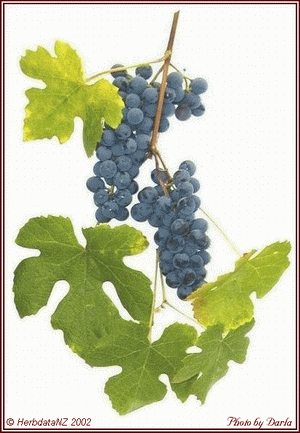

Vitis vinifera L. (Vitaceae)
Commentary
by Ivor Hughes
Common names: European Grape, Grape, Wine grape
Habitat : Universal in warm and temperate regions of the globe. There are circa 50 recognised species but there will without doubt be more that have not been catalogued.
Chemistry: The chemistry is far too lengthy to include in this monograph, however a link to Dr James Duke's Plant Database will be included at the bottom of the monograph. Simply enter either the common name or the botanical name and choose your preferences.
Economic Use : The grape is food, drink and medicine when used as a 3 day grape fast in order to detoxify the liver. However it is most used to produce the worlds first choice in recreational drugs. Alcohol. Grape wines are produced in profuse variety, and so, are the foremost of the fruit wines. So much did the
ancients value grapes and the vine that legends and cults sprang up around its mind altering properties. In Greek cosmology and legend we have Dionysus, God of Grape and Wine. Dionysus appeared in the Roman Pantheon as Bacchus. Wine is also the distillation base for the production of grape spirit or Brandy. Brandy must be aged in non charred wooden casks for a period of not less than 4 years to earn the title of Brandy. During that aging period it will undergo chemical changes and absorb constituents from the wood. For example tannin, which has a marked physiological effect. In commerce, brandy, whiskey, rum and other spirits are classified as the ardent spirits.
Spirits of Wine as Solvent : Brandy would first need to be rectified to produce spirits of wine. Alcohol produced from wine never contains any of the higher alcohols which are collectively known as 'Fusel Oils ' or congeners. This is an important point for the congeners can be extremely destructive of plant materials as well as livers. To the chemist, alcohol is alcohol, with a formulae of CH3 CH2OH. Commonly referred to as Ethyl Alcohol or Ethanol. A Perfumer or Herbal Pharmacist (Spagyric) would consider that to be incorrect. From direct practical experience, they have detected subtle differences in results, depending on which vegetable substance has been used to produce the alcohol. This phenomena has not been explained by science. If producing perfumes use a grain based alcohol. If producing herbal extracts or tinctures then spirits of wine is the preferred medium.
When producing the diluted or aqueous alcohols use distilled water as the medium. Spring waters will have a different chemical composition depending up on which region they have been obtained. Most importantly, through what kind of strata have they risen.? Globally, rain now contains the condensed particulates of industrial and chemical pollution. Tap water is equally suspect. A Spagyric extract is prepared, by using the spirits of the plant, which is to be extracted, and the condensed vapours from the plant, as it undergoes the drying process is used to dilute the alcohol to a specified strength.
The phyto data base of James Duke :
http://www.ars-grin.gov/duke/
Ivor Hughes
![]()